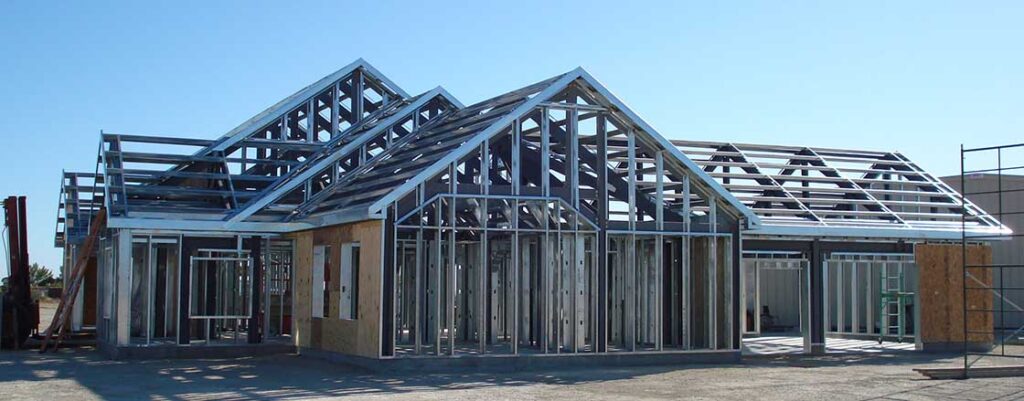
This vapor barrier is composed of three layers (PP-TL-PP) that ensure high vapor breathability over the long term, while transforming the lower surface into a waterproof layer (class W1). It provides temporary protection against rain during roof installation and serves as a double-waterproofing surface for the finished roof, channeling any water infiltration to the gutters. The roof was fully covered and protected with this vapor barrier.
Benefits of the traditional steam barrier
Reduces energy wastage
Provides two-way vapor permeability control
Protects against moisture re-entry into thermal insulation
The three-layer construction ensures excellent resistance to the aging processes.
The vapor barrier layer is suitable for use in double-wall facades, such as composites, wood, siding, prefabricated walls, and sloping roofs, including flexi, clay, and metal roofs. It retains its properties, even under harsh weather conditions. With its unique structure, this insulation provides protection against water, rain, and snow that may penetrate buildings from layer to layer. It also prevents the corrosion and decay of the frame and other thermal insulators, such as glass wool, under sloping roofs.



Constructed with non-woven layers, this insulation provides more strength than insulators, such as waterproofing. Its breathability allows evaporated moisture to pass through, preventing the formation of mold and fungus in the building and prolonging its lifespan. This feature is not found in traditional insulations such as waterproofing. The insulation can be installed on any roof or façade surface, is lightweight, and has a smaller volume compared to other insulations (waterproofing), along with its ease of installation without the need for heating, resulting in cost savings and faster execution. Using non-woven layer technology, cold and hot air movement and passage through the building’s body and roof cracks and failures are prevented, leading to a 35% reduction in energy loss.
Using non-woven layers in construction, vapor barriers provide greater roof strength than insulators such as the ISO. The breathability of the vapor barrier allows evaporated moisture from the shingle roof to pass through, preventing the growth of fungi and molds and increasing the lifespan of the building ceiling, body structure, and roof. A vapor barrier typically consists of two layers of polyester fabric with a middle layer of compressed polyethylene. It functions by creating a barrier against water and moisture on one side, while allowing moisture and steam to escape from the other. This insulation is cost-effective, easy to install, and quick to execute, making it an excellent option for homeowners.
The vapor barrier utilizes non-woven layer technology to prevent hot and cold air from passing through the cracks and failures of the building structure, thus reducing energy loss by at least 35%. Advancements in insulation construction have provided superior water penetration resistance, high durability, longevity, and easy installation at a very low cost compared to traditional insulation. Unlike other insulations, the vapor barrier allows the structure to breathe and is lightweight. Unlike waterproofing, it does not require heating during installation. Instead, special nails or petroleum-based adhesives can be installed.



The classic vapor barrier has various applications, such as serving as a protective cover for the roof, forming a foundation for sloping roofs with thermal insulation (ventilated), and being used under different types of roof coverings, particularly mosaics and concrete tiles. It can also be utilized for wind protection and concrete processing.
Isoflex with aluminum coating
This vapor barrier is composed of four layers (PP, ALU, TL, and PP) and is recommended for nonventilated roofs. It is particularly resistant to tearing and stretching, making it ideal for roofs in areas with a high moisture content, such as swimming pools, restaurants, and canteens. This barrier helps maintain a healthy and fresh environment. To prevent condensation from forming inside the vapor barrier, it is important to ensure that the insulation material is properly sized and that the dew point remains outside the barrier, even under extreme temperature and humidity conditions. Inadequate insulation can result in condensation inside the vapor barrier, leading to leakage and potential damage.
Isoflex-pro vapor barrier
The vapor barrier layer serves as a means of effectively impeding the transfer of water vapor in specific conditions. Moisture produced by building residents, special appliances, plants, and plumbing systems generates water vapor that enters the air. The vapor barrier guarantees long-term high levels of vapor breathability while converting the lower surface into a completely waterproof layer (Class W1). Composed of five layers (PP, TL, PP, TL, and PP), this vapor barrier is a fully breathable membrane that is applicable to all building components. Its high longevity, breathability, and waterproofness ensure the longevity of buildings.
Vapor barrier with temperature control
The vapor barrier layer effectively inhibits the transfer of water vapor under specific circumstances. Various factors, such as the residents of the building, appliances, plants, and plumbing can generate moisture that condenses in the air as water vapor. This type of vapor barrier is comprised of three layers: PP, TL, and TPU.
This is a state-of-the-art membrane with an exceptional performance. It offers the unique ability to control temperature at any given time and is also an anti-UV agent to protect against sun damage. Additionally, there is a long warranty to guarantee its effectiveness. This membrane ensured insulation, which ultimately resulted in material and energy savings. Their weather resistance makes them a reliable choice for various applications.



Places that require the isoflex vapor barrier layer:
For regions with cold winter weather, the vapor barrier layer should be placed towards the interior of the living space, which is warmer. Conversely, in humid climates or areas with frequent air conditioning, they should be installed on the exterior of the wall.
Types of vapor barrier:
A rating score ranging from 0 to 1 was assigned to each material to evaluate its suitability as a vapor barrier layer in residential buildings. This score measures the resistance of the material to water vapor penetration. The ASHRAE Fundamentals Handbook and other industry sources provide ratings for common building materials, as shown in the table below.
When is a vapor barrier layer required?
Recent studies on moisture prevention and the use of vapor barrier layers have led to significant changes in the building standards. The International Code Council (ICC) has summarized these standards in the 2009 edition, defining vapor barrier layers into three classes based on their impermeability to water vapor: Class I, II, and III. The lowest impermeability value transmitted the least amount of water vapor through the vapor barrier layer. Class I is considered highly impermeable, with a moisture absorption value of approximately 0.1 or less. Examples of Class I vapor barrier materials include polyurethane and aluminum sheets.
A brief description of the vapor barrier can be summarized as follows
Vapor barrier insulation is suitable for use in all double-wall facades of buildings, including, but not limited to, gamposit, wood, siding, lsf, fiber cement, aquapanel, prefabricated walls, and sloping roofs such as shingles, clay, and metal. Its unique structure provides protection against water infiltration from rain and snow, which can damage the main walls and other insulating materials, such as glass wool. Moreover, the breathability of Isoflex 100 vapor barrier insulation allows evaporated moisture to pass through, while preventing the growth of mold and fungus, thus increasing the lifespan of the building. This feature is not present in traditional insulation such as waterproofing. Additionally, the use of non-woven layer technology in vapor barrier insulation prevents the movement of hot and cold air between cracks and failures in the building’s body and roof, thus preventing energy loss of up to 35%..
















